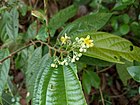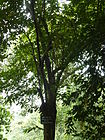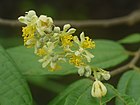Note: This is a project under development. The articles on this wiki are just being initiated and broadly incomplete. You can Help creating new pages.
Difference between revisions of "Microcos paniculata"
| Line 1: | Line 1: | ||
| − | + | [[File:Microcos paniculata- Microcos, Kottakka.jpg|thumb|right|''Microcos paniculata'']] | |
| + | '''Microcos paniculata''' (simplified Chinese: 布渣叶; traditional Chinese: 布渣葉) is a flowering shrub native to China and south-east Asia. It is sometimes added to Chinese herbal tea, having a mildly sour taste. In traditional Chinese medicine the plant is believed to help the digestive system, and it is also used for other health problems including colds, hepatitis, diarrhea, heat stroke, and dyspepsia. None of these alleged claims have shown to be effective in clinical trials. The herb may have a placebo effect. | ||
==Uses== | ==Uses== | ||
| − | {{Uses|}}, {{Uses|}}, {{Uses|}}, {{Uses|}}, {{Uses|}}, {{Uses| | + | {{Uses|antidiarrheal}}, {{Uses|antimicrobial and insecticidal}}, {{Uses|anti-inflammation}}, {{Uses|hepatoprotective}}, {{Uses|cardiovascular protective}}, {{Uses|blood lipids reducing}}. |
==Parts Used== | ==Parts Used== | ||
| − | {{Parts Used| | + | {{Parts Used|Leaves}}. |
==Chemical Composition== | ==Chemical Composition== | ||
| + | The stem bark of Microcos paniculata contained a new alkaloid, N-Methyl-6 beta-(deca-1',3',5'-trienyl)-3 beta-methoxy-2 beta-methylpiperidine, which showed good insecticidal activity against Aedes aegypti second instar larvae. | ||
<ref name="chemical composition"/> | <ref name="chemical composition"/> | ||
==Common names== | ==Common names== | ||
| − | {{Common names | + | {{Common names|kn=|ml=|sa=|ta=|te=|hi=पहाड़ी पुदीना Pahari Pudina|en=Spearmint, Garden mint, Lamb mint}} |
==Properties== | ==Properties== | ||
Reference: Dravya - Substance, Rasa - Taste, Guna - Qualities, Veerya - Potency, Vipaka - Post-digesion effect, Karma - Pharmacological activity, Prabhava - Therepeutics. | Reference: Dravya - Substance, Rasa - Taste, Guna - Qualities, Veerya - Potency, Vipaka - Post-digesion effect, Karma - Pharmacological activity, Prabhava - Therepeutics. | ||
===Dravya=== | ===Dravya=== | ||
| + | |||
===Rasa=== | ===Rasa=== | ||
| − | |||
===Guna=== | ===Guna=== | ||
| − | |||
===Veerya=== | ===Veerya=== | ||
| Line 29: | Line 30: | ||
==Habit== | ==Habit== | ||
| − | {{Habit|}} | + | {{Habit|Tree}} |
==Identification== | ==Identification== | ||
===Leaf=== | ===Leaf=== | ||
| − | {{Leaf|||}}<ref name="Leaf"/> | + | {{Leaf|Simple| Leaves 3-costate, elliptic-lanceolate or ovate-lanceolate, |8.5-13.5 cm long, 4-5.5 cm broad glabrous except for stellate hairs on veins and veinlets beneath, entire or slightly serrate; petiole 0.8-1.2 cm long, hairy; stipules linear-lanceolate, c. 8-10 mm long}}<ref name="Leaf"/> |
===Flower=== | ===Flower=== | ||
| − | {{Flower||||}} | + | {{Flower|Unisexual|8-15 cm long|yellowish-white||8-10 mm across; pedicels small, hairy; bracts subulate, c. 3-4 mm long, caducous. Sepals linear-oblong, 6-7 mm long, 2.5-3 mm broad, densely hairy outside, cucullate at the apex. }} |
| − | |||
| − | |||
===Other features=== | ===Other features=== | ||
| Line 46: | Line 45: | ||
==Where to get the saplings== | ==Where to get the saplings== | ||
| − | |||
==Mode of Propagation== | ==Mode of Propagation== | ||
| − | {{Propagation|}} | + | {{Propagation|Seeds}}. |
==How to plant/cultivate== | ==How to plant/cultivate== | ||
| + | |||
<ref name="How to plant/cultivate"/> | <ref name="How to plant/cultivate"/> | ||
==Commonly seen growing in areas== | ==Commonly seen growing in areas== | ||
| − | {{Commonly seen|}}, {{Commonly seen|}} | + | {{Commonly seen|Eastern Bengal}}, {{Commonly seen|Khasia mountains}} |
==Photo Gallery== | ==Photo Gallery== | ||
<gallery class="left" caption="" widths="140px" heights="140px"> | <gallery class="left" caption="" widths="140px" heights="140px"> | ||
| − | + | File:Microcos paniculata- Microcos, Kottakka 2.jpg | |
| + | File:Microcos paniculata.JPG | ||
| + | File:Microcos paniculata (4801892357).jpg | ||
| + | File:Microcos (5852209813).jpg | ||
</gallery> | </gallery> | ||
==References== | ==References== | ||
<references> | <references> | ||
| − | + | <ref name="chemical composition">[https://www.researchgate.net/publication/12471135_Insecticidal_piperidine_alkaloid_from_Microcos_paniculata_stem_bark "sciencedirect"]</ref> | |
| − | <ref name="chemical composition">[" | + | <ref name="Leaf">[http://www.flowersofindia.net/catalog/slides/Shiral.html "Botonomy"]</ref> |
| − | |||
| − | <ref name="Leaf">[" | ||
| − | |||
<ref name="How to plant/cultivate">[ "Cultivation"]</ref> | <ref name="How to plant/cultivate">[ "Cultivation"]</ref> | ||
| − | |||
</references> | </references> | ||
==External Links== | ==External Links== | ||
| − | * [ ] | + | * [http://www.flowersofindia.net/catalog/slides/Shiral.html Microcos paniculata] |
| − | + | ||
| − | |||
[[Category:Herbs]] | [[Category:Herbs]] | ||
| − | [[Category: | + | [[Category:Tiliaceae]] |
Revision as of 14:54, 5 June 2020
Microcos paniculata (simplified Chinese: 布渣叶; traditional Chinese: 布渣葉) is a flowering shrub native to China and south-east Asia. It is sometimes added to Chinese herbal tea, having a mildly sour taste. In traditional Chinese medicine the plant is believed to help the digestive system, and it is also used for other health problems including colds, hepatitis, diarrhea, heat stroke, and dyspepsia. None of these alleged claims have shown to be effective in clinical trials. The herb may have a placebo effect.
Contents
- 1 Uses
- 2 Parts Used
- 3 Chemical Composition
- 4 Common names
- 5 Properties
- 6 Habit
- 7 Identification
- 8 List of Ayurvedic medicine in which the herb is used
- 9 Where to get the saplings
- 10 Mode of Propagation
- 11 How to plant/cultivate
- 12 Commonly seen growing in areas
- 13 Photo Gallery
- 14 References
- 15 External Links
Uses
antidiarrheal, antimicrobial and insecticidal, anti-inflammation, hepatoprotective, cardiovascular protective, blood lipids reducing.
Parts Used
Chemical Composition
The stem bark of Microcos paniculata contained a new alkaloid, N-Methyl-6 beta-(deca-1',3',5'-trienyl)-3 beta-methoxy-2 beta-methylpiperidine, which showed good insecticidal activity against Aedes aegypti second instar larvae. [1]
Common names
| Language | Common name |
|---|---|
| Kannada | |
| Hindi | पहाड़ी पुदीना Pahari Pudina |
| Malayalam | |
| Tamil | |
| Telugu | |
| Marathi | NA |
| Gujarathi | NA |
| Punjabi | NA |
| Kashmiri | NA |
| Sanskrit | |
| English | Spearmint, Garden mint, Lamb mint |
Properties
Reference: Dravya - Substance, Rasa - Taste, Guna - Qualities, Veerya - Potency, Vipaka - Post-digesion effect, Karma - Pharmacological activity, Prabhava - Therepeutics.
Dravya
Rasa
Guna
Veerya
Vipaka
Karma
Prabhava
Habit
Identification
Leaf
| Kind | Shape | Feature |
|---|---|---|
| Simple | Leaves 3-costate, elliptic-lanceolate or ovate-lanceolate, | 8.5-13.5 cm long, 4-5.5 cm broad glabrous except for stellate hairs on veins and veinlets beneath, entire or slightly serrate; petiole 0.8-1.2 cm long, hairy; stipules linear-lanceolate, c. 8-10 mm long |
Flower
| Type | Size | Color and composition | Stamen | More information |
|---|---|---|---|---|
| Unisexual | 8-15 cm long | yellowish-white | 8-10 mm across; pedicels small, hairy; bracts subulate, c. 3-4 mm long, caducous. Sepals linear-oblong, 6-7 mm long, 2.5-3 mm broad, densely hairy outside, cucullate at the apex. |
Other features
List of Ayurvedic medicine in which the herb is used
Where to get the saplings
Mode of Propagation
How to plant/cultivate
Commonly seen growing in areas
Eastern Bengal, Khasia mountains
Photo Gallery
References
- ↑ "sciencedirect"
- ↑ "Botonomy"
- ↑ [ "Cultivation"]
External Links
- Ayurvedic Herbs known to be helpful to treat antidiarrheal
- Ayurvedic Herbs known to be helpful to treat antimicrobial and insecticidal
- Ayurvedic Herbs known to be helpful to treat anti-inflammation
- Ayurvedic Herbs known to be helpful to treat hepatoprotective
- Ayurvedic Herbs known to be helpful to treat cardiovascular protective
- Ayurvedic Herbs known to be helpful to treat blood lipids reducing
- Herbs with Leaves used in medicine
- Herbs with common name in Hindi
- Herbs with common name in English
- Habit - Tree
- Index of Plants which can be propagated by Seeds
- Herbs that are commonly seen in the region of Eastern Bengal
- Herbs that are commonly seen in the region of Khasia mountains
- Herbs
- Tiliaceae




